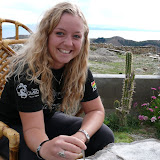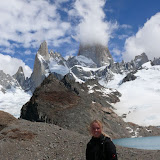Gut, wo war ich stehen geblieben….ich bin ja dann am 22. Januar mit dem Bus etwa 9 Stunden von Arica/Chile nach La Paz/Bolivien gefahren. Das war dann von Meereshöhe auf etwa 3800 Höhenmeter….zur höchsten Stadt der Welt. Die Höhenkrankheit hat auch von mir nicht Halt gemacht, so hatte ich während der Busfahrt schreckliche Kopfschmerzen. Vom Hotel wurde ich am Busbahnhof abgeholt, und hab dann erst mal ein wenig geschlafen. Den ganzen Samstag hab ich dann im Hotelzimmer gearbeitet, und meine Bachelorarbeit war soweit eigentlich dann schon fertig. Abends ist dann Gabriel von Lima/Peru nach La Paz geflogen und wurde auch vom Hotel abgeholt….dann sind wir erst einmal was went to eat. On Sunday, 24 January we have done something really exciting. We are on a mountain bike of 4700 meters to 1200 meters, which distributed a total of 3500 meters above 65km, driving the most dangerous road in the world, namely the Yungas Road. She also has a nickname, namely "Death Road" because about 300 people die each year there. Until we are there long-run, in 2010, already 20 people have died. But it sounds now, tragically, as it actually is. Dangerous it is, namely, when 2 buses meet on the narrow road, and then a slip. With a mountain which rarely happens! Arrived In the valleys we then stopped still for late lunch and back to La Paz on Monday, we have made then sightseeing in the city, and proofreading my dissertation. Tuesday morning we took the bus to Copacabana on Lake Titicaca, and then placed there by boat to the Isla del Sol. Lake Titicaca is the highest navigable lake in the world, and of course, were also here the Incas. It is in Lake Titicaca, Isla de la Luna, which was formerly inhabited, and on the Isla del Sol, only the temple. Even today it is on the Isla del Sol, no cars, you have to run the roads so completely on foot, the island is now inhabited mainly, and there are many tourists here. The highest Point is above 4000 meters, and with luggage it is a much short-winded ...! Gabriel is so difficult to altitude sickness, but has existed in Copacabana, waiting to take all his bags for a night on the island, to me, however, has served my small backpack with a notebook, camera and cables (also my valuables), including exchange underwear already. Until we arrived at our hotel on the island with panoramic views, but we are running about 4 km in just under 2 hours. ... Are left luggage at the hotel, then another 4km to the Inca ruins to visit and then back again. Meanwhile, it is then already become cold and dark ....'s Power was only 3 h motor operated in the evening, and hot water war auch Mangelware; Internet und Handynetz ein schöner Wunschtraum! Am nächsten Tag in der Früh hat´s dann geschüttet wie verrückt und Gabriel ging es auf 4000 Höhenmetern noch schlechter, somit hab ich seinen großen Reiserucksack auf dem Rücken und meinen kleinen Rucksack vorne die 3km zum anderen Strand ne Stunde lang geschleppt, um dann mit dem Boot wieder zurück nach Copacabana zu kommen. Die ganze Stadt wieder mit beiden schweren Rucksäcken abgelaufen, bis ich endlich in nem Restaurant den Großen stehen lassen konnte, sind wir dann in die Kirche, die eine ganz berühmte Madonnenstatue hat. Nach dem Mittagessen sind wir dann über die peruanische Grenze nach Puno gefahren, das auch am Titicacasee liegt. From there we were on the famous "Islas Flotantes", or a tribe that has fled from hundreds of years before the Incas, and built with the plants has navigable islets, where the houses stand on it. That was really impressive, but I think because the photos tell more in the notes! Back in Puno we have llama meat eaten dinner and are then continued with the night bus to Cusco. Since the rainy season here, which is currently extremely bad, it was a lot of flooding and in the region of Cusco emergency was declared. In newspapers, is that about 1400 tourists had to be flown by helicopter from Macchu Picchu. Macchu Picchu is accessible only by train - or the Inca Trail on foot. The railway line was destroyed over a distance of 12km completely and still there is the danger of landslides coming down. ... So very dangerous ....! When we arrived in Cusco, it stopped raining for about the same time, the repair work but are estimated at over 1 month ... ..! Since all bridges and roads were destroyed in the region, we would have gone quite complicated by bus about 40 hours NEN huge detour to get to Lima. In the near region, unfortunately, no inspection was possible. Yesterday, 10 times proofread my Bachelor thesis, we are a little through the beautiful city of Cusco run. Inca Culture and Colonial are here passed over into one another. ... A beautiful city!! In the short term we could this afternoon for a flight organization with which we have now arrived in Lima. Now that the work Bachelor number 1 is sent, it's off first along the coast further north. ... Well to the equator, and then we'll see which route we take back south. On 12 February we will definitely fly to Germany .... And then my semester officially and unofficially over! If possible, I deliver in about a week but once again, an interim report.
Love, Verena
mirror, 26 January
mirror, 27 January
Latina-Press, 27 January
mirror, 29 January
Reuters video, 29 January
 |
| 7th Part 2 months |


